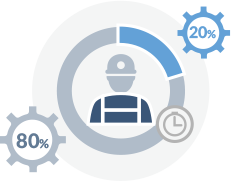What is Apprenticeship?
Why Apprenticeship?
Common Apprenticeship Terms
Apprentice

- Is a paid employee
- Spends 80% of time on the job & 20% in technical training
- Is supervised by a certified journeyperson
- Must be registered with their P/T apprenticeship authority
- Often qualifies for financial supports while in school
Journeyperson

- Has completed all training requirements to be certified
- Passed their certification exam
- Acts as a mentor to a registered apprentice while working in their trade
- Provides training opportunities for each level of the apprentice’s program
- Signs off on the apprentice’s competencies
Skilled Trades

- Encompass a broad range of exciting, hands-on careers
- Fall in four main sectors: construction, manufacturing, motive power & service
- Include more than 300 occupations in Canada
- Are subject to standards and training requirements set out by P/T legislation
- Increasingly require technologically advanced and critical thinking skills
Apprentice Authorities

- Regulate and administer apprenticeship training at the P/T level
- Determine educational requirements, length and competencies for an apprenticeship in their region
- Uphold program standards & preside over examinations
- Issue Certificates of Qualification
Log Book

- Often provided by the apprenticeship authority upon registration
- Outlines skills associated with the skilled trade
- Is signed by the journeyperson mentor indicating a competency has been achieved
- Provides a record of apprentice progress and hours worked
- May be paper-based or electronic
Red Seal Program

- Is Canada’s interprovincial, national standard of excellence
- Was established to ensure tradesperson mobility across country
- Indicates a journeyperson has met a common standard of knowledge & experience in their trade
- Is an endorsement provided upon passing the Red Seal exam with score of 70% or higher
5 Steps to Becoming an Apprentice
If you are considering a career in the skilled trades, apprenticeship is the most common way of developing the skills you need to be certified. Here are some basic steps to keep in mind if apprenticeship is your post-secondary pathway of choice.

Finish High School
- Grade 12 is the minimum requirement for apprenticeship in most trades
- Before graduation, take courses that will be an asset to your apprenticeship
- Ensure math and science skills align with your chosen trade
- Develop problem-solving, critical thinking, communication, teamwork & digital skills

Choose a Trade
- Assess your interest and skills; consider occupations that align
- Get advice from parents, teachers and tradespeople
- Consult local employers to discover in demand trades
- Visit a college to find out about pre-apprenticeship programs

Get Hired
- Start your job search – online and in-person
- Approach employers to express interest
- Consider proving yourself as a labourer first then move to apprenticeship
- Contact trades unions to find out about apprentice intakes

Register & Train
- Follow steps from your regional apprenticeship authority to become an apprentice
- Sign any required contracts outlining program length and wages you will receive
- Use provided logbook to track your skills development
- Understand when you will go to technical training

Start Your Career
- Complete required hours of on-the-job training & attend all levels of technical training
- Pass the exam for your trade & get your Certificate of Qualification
- Continue working on the tools or look for opportunities to become a supervisor, mentor, entrepreneur, union representative or college instructor
- How far you go is up to you!

